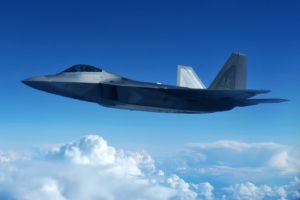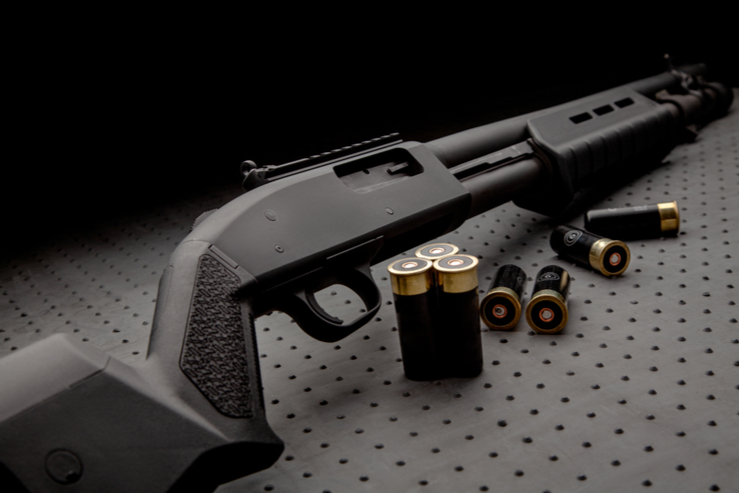 The F-22 Raptor, designed for both air-to-air and air-to-ground combat is the most dangerous stealth fighter in the world. So why was it cancelled? A memoir by retired Gen. Norton Schwartz states that the F-22 stealth fighter was eventually traded for the B-21 bomber. Defense secretary Robert Gates argued that the F-22 was a cold war relic and it was useless in the Afghanistan and Iraq counterinsurgencies. He also argued that the Chinese stealth fighter wouldn’t be fielded until at least 2020, when in fact, China’s J-20 stealth fighter hit the skies in 2017 and the F-22 has been a pivotal component in the Syrian campaign. In opposition to Gates’ criticisms, every Combat Command chief since his tenure has argued that the F-22 Raptor force is too small.
The F-22 Raptor, designed for both air-to-air and air-to-ground combat is the most dangerous stealth fighter in the world. So why was it cancelled? A memoir by retired Gen. Norton Schwartz states that the F-22 stealth fighter was eventually traded for the B-21 bomber. Defense secretary Robert Gates argued that the F-22 was a cold war relic and it was useless in the Afghanistan and Iraq counterinsurgencies. He also argued that the Chinese stealth fighter wouldn’t be fielded until at least 2020, when in fact, China’s J-20 stealth fighter hit the skies in 2017 and the F-22 has been a pivotal component in the Syrian campaign. In opposition to Gates’ criticisms, every Combat Command chief since his tenure has argued that the F-22 Raptor force is too small.
An article by Tyler Rogoway and Joseph Trevithick of The Drive talks about the F-22 production restart study the USAF has kept secret for years. In the article they talk about how weapons systems can be distorted using different calculations to make one weapons system look more affordable than another. Below are some areas not mentioned in the Production Restart report that could potentially reduce the cost of any possible F-22 program restart.
The Air Force repeatedly expressed a concern that the rebooted effort would compete for resources with its F-35 procurement and upgrade efforts. However, the report also says the service did not consider whether any of the Joint Strike Fighter’s components, supply chains, or infrastructure could help support a new F-22 program and potentially produce cost savings.
The service also determined that it was still “technically feasible” to develop an export version of the F-22, potentially helping to share the cost burdens and reduce the unit costs even further. The report cites a separate 2010 Air Force study that estimated the costs of doing just that. In addition, the service reiterated the long-standing challenges in securing approval for exporting F-22s in any configuration. The report identifies a number of U.S. government stakeholders who would have to sign off on any foreign deliveries, but Air Force censors redacted all of them.
The non-recurring costs of putting the Raptor back into production seem peculiarly high in this report, estimated at around $10 billion. Keep in mind that is roughly half of the entire development cost of the B-21 Raider stealth bomber. In addition, this study states that unit cost would be fairly steady, especially after the first 100 examples, dropping to $206 million for the final example. This doesn’t make much sense considering all other major defense programs seem to tout steeper unit cost reductions over a production run, and especially over the first production lots. The F-35 program, for instance, has placed a huge part of its business case on this fact alone.
When it comes to fly-away cost—what the actual aircraft costs to build itself, without research and development costs included— the last 60 F-22s that were produced during its production run cost an average of $137 million per copy, which was approaching the F-35A’s cost during the same time in its production run. In fact, then-Air Force Chief of Staff General Michael Mosely, who lost his job because he would not stand by and watch then-Secretary of Defense Robert Gates make the decision to cut F-22 production without a fight, noted:
“We didn’t, and still don’t need, a thousand of those things. But you need the right number… The last airplanes we took delivery of were $87 million… Had we been able to go to another multiyear [contract] there was an understanding that we would be able to get them for $85 million… Find me an airplane out there right now that costs $85 million and has that capability.”
So, it seems likely that further reductions in production cost could be realized beyond what the restart study states, and especially considering the F-22 is a known commodity, not some new fighter just entering into production. The study uses some references to say otherwise, but
This is also a reminder of how costs of weapon systems can be distorted using different calculations to make one look far more affordable than another. The reality is that the F-22 program cost $70 billion and roughly $30 billion of that was spent on non-recurring and research and development costs. So if you build less of them and amortize that over the small fleet, it looks fiscally atrocious. In reality, what’s atrocious is that the $30 billion spent on developing a system like F-22 would be wasted on such a tiny fleet.
As we have stated before, the conclusions of this study were likely baked into it before it really even began and at this point investing huge sums of money into restarting F-22 production doesn’t make all that much sense. That money could be invested other programs like the USAF’s ‘Penetrating Counter-Air’ initiative and especially in high-end unmanned combat air vehicles.
But if another country, say Japan, were willing to pay for the non-recurring restart costs, the Pentagon would be crazy not to buy more Raptors for largely their unit cost alone as well as plenty of spare parts to support the fleet efficiently for decades to come.
Read the full story here.



